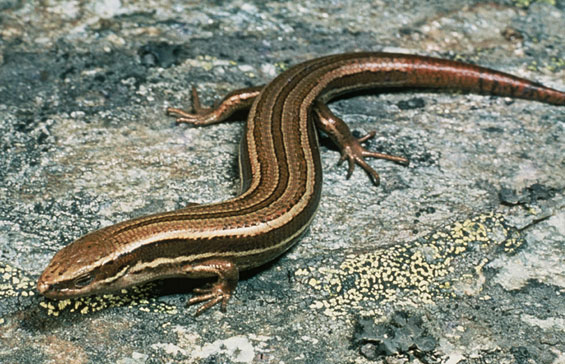Introduction
Northern grass skink are avid baskers, and abundant in coastal areas.New Zealand status: Native
Conservation status: Not threatened
Population: Unknown
Found in: A wide range of habitat but often in rough pasture grass and some urban gardens
Threats: Habitat loss, predation, disturbance
Scientific name: Oligosoma polychroma
Recognition
Northern grass skinks are often abundant in coastal locations where they are often a dark or black colour. In other places they are brown with irregular stripes.
They can be distinguished from the similar brown skink by their straw coloured iris (brown skinks have a brown iris). Northern grass skinks are not threatened.

Northern grass skinks have distinctive stripes, and their eyes have a straw coloured iris
Behaviour
Northern grass skinks reach sexual maturity when they are about four years old, and have on average 5-6 young each year.
Individuals that have a larger body size (length) tend to have more young than smaller bodied individuals. Females are slightly larger than males.
The most common food of Northern grass skinks is invertebrates, namely beetles, spiders, and the caterpillars of moths and butterflies. They also eat a small amount of seeds and fruit.
All lizards are cold blooded animals. This means that, unlike in mammals, lizards absorb heat from the environment rather than generate it internally. Many lizards bask in the sun to get warm, and if they aren’t warm enough they have difficulty moving. The body temperature that a lizard can achieve has a profound effect on important life-traits – low temperatures can lengthen pregnancy, and can even result in the unborn baby’s (neonate’s) death.
Habitat
Northern grass skinks are avid baskers. They seek sun and prefer sunny habitats. They often minimise the risk of predation by exposing only small parts of their body at one time, still remaining well hidden.
Northern grass skinks love sunny rock piles and tumbles that have plenty of crevices. Not only are they great for basking in safe spots, but rock retains heat to keep them warm during cold spells.
Northern grass skinks prefer grasslands (especially tall grass species or rank grass), scrublands and vinelands rather than forests. They love dry, open areas with lots of places to bask and lots of cover to hide under.